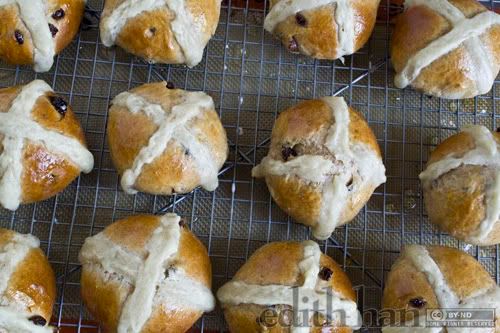
Hot cross buns! Hot cross buns! One-a-penny, Two-a-penny, Hot cross buns! So everyone's heard of hot cross buns, but it turns out that most people I know have never actually had them, nor do they know what they are. In fact, most people (including myself) only know the first two lines of the nursery rhyme, haha.
So what are hot cross buns? They're generally associated with Easter, and more specifically, Good Friday, with the cross symbolizing The Crucifixion. However, it seems that the hot cross bun actually predates Christianity! Their origins lie in pagan traditions of ancient cultures, celebrating the vernal equinox (Eostre), with the cross possibly representing the balance between light and darkness of the equinox, the four quarters of the moon, or the symmetry of the seasons. During early missionary efforts, the Christian church adopted the buns and re-interpreted the icing cross. In 1361, a monk named Father Thomas Rockcliffe began a tradition of giving Hot Cross Buns to the poor of St. Albans on Good Friday.
Now wasn't that an exciting history lesson?
Anyhow, simply put, hot cross buns is a sweet, spiced yeast bun with currants (or raisins) and often candied citrus peel, and has a cross of a sweet dough on top (though many people now just use an icing for the cross).
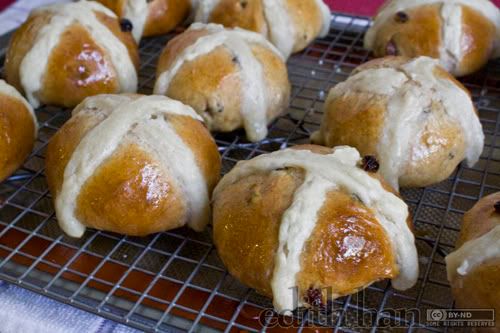
I adapted the recipe from Wild Yeast Blog, and oh my goodness is it delicious. I didn't have dried currants, or candied lemon/orange peel, so I just made it with raisins and added a little bit of lemon simple syrup I made while candying lemon slices (I'll write about it later, but it's negligible for the recipe). I saw dried currants at a local farmer's market, so I might get those some day and make these again! Click below for recipe.
Hot Cross Buns
Makes 12 buns. Adapted from Wild Yeast Blog.
Ingredients
Sponge
* 37 g (1/4 cup + 2 TBSP) flour
* 190 g (3/4 cup + 1 TBSP) milk, ~100F
* 1 1/2 tsp sugar
* 2 1/4 tsp instant yeast
Final Dough
* 170 g (1 1/2 cups) AP flour
* 170 g (1 1/2 cups) whole wheat flour
* 60 g (~4 TBSP) butter, softened
* 57 g (1/4 cup + 1/2 TBSP) sugar
* 1 egg
* 1/2 tsp salt
* 1/2 tsp ground allspice
* 1/2 tsp ground cinnamon
* 1/4 tsp freshly grated nutmeg
* 1/4 tsp ground ginger
* 1 TBSP water
* 1 1/2 cups dried currants or raisins
Sweetdough Piping Paste
* 150 g (1 1/3 cups) AP flour
* 30 g 1/4 cup confectioner's sugar
* 50 g (~1.5 TBSP) vegetable oil
* 120 g (~1/2 cup) water
Glaze
* 60 g (1/4 cup) water
* 60 g (1/4 cup + 2 TBSP) sugar
* ~1/2 TBSP apricot jam (optional)
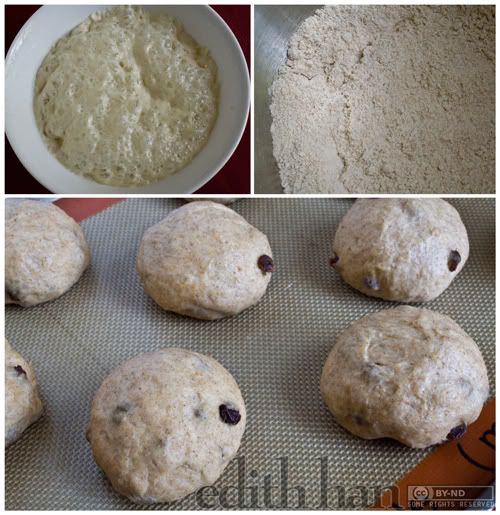
Directions
1. For sponge: Combine milk and yeast into a medium bowl. Whisk in flour and sugar. The mixture will be very liquid. Cover and let rest in warm place until 3 times its original volume (30-40 minutes).
2. In the mean time, make final dough mixture. Sift together AP flour and whole wheat flour in a large bowl. Stir softened butter into flour mixture until evenly distributed. I ended up using my hands to mix it in. The mixture will be very dry and sand-like.
3. Mix in egg, sugar, allspice, cinnamon, nutmeg, ginger, and salt. The mixture will still be very dry.
4. Add the sponge to flour mixture. Using a spoon, slowly mix the sponge and flour mixture together. When firm enough, use hands to knead the dough. Slowly add water until it makes a very soft dough if necessary (I didn't need any). Knead until well mixed. It should be similar to a cookie dough, and will barely come together. Continue mixing until the dough becomes tacky and gluten begins to form (10-15 minutes).
5. Add currants/raisins (and candied lemon/orange peel if you have it). Knead dough until they are evenly distributed.
6. Transfer dough to lightly oiled bowl. Cover, and let rest and rise in a warm place with 1 hour, with a fold (Pull out dough, fold in 1/3. Turn it 90 degrees, and fold it in 1/3 the other way.) at 30 minutes.
7. Turn the dough out onto a floured surface. Divide into 12 pieces (~74 g each).
8. Lightly degas each piece of dough, and form into a ball. To tighten the ball, place it on the counter with your cupped hand loosely around it, and move your hand in a tight circle several times.
9. Place the balls on a parchment-lined baking sheet ~1/2" apart. Press them lightly with your palm to flatten them a bit.
10. Cover buns and proof in a warm place for about an hour.
11. While the buns proof, make the glaze. Combine the sugar and water (and apricot jam) in a small saucepan and bring the mixture to a rolling boil, stirring often. Remove from the heat and set aside.
12. Preheat the oven to 440F.
13. Now make the piping paste. Sift the AP flour with the powdered sugar and combine it with the vegetable oil. Slowly add water, stirring well after each addition, until the mixture reaches the consistency of very thick glue. Don’t make it so thin that it runs, but if it is too thick it will be difficult to pipe. I did this in a heavy duty Ziplock bag so I could just snip the corner later to pipe the crosses.
13. When the buns are finished proofing, pipe the crosses onto them using a pastry bag fitted with a 1/4-inch round tip or a snipped corner of your bag. (The round tip would make it prettier, but I managed.)
14. Bake the buns on the parchment-lined sheet at 440F until the tops are browned, about 7 minutes. Reduce the heat to 400F and continue baking until browned all over, about another 8 minutes.
15. Cool buns on a cookie rack. While the buns are still hot, brush them with a light coating of glaze.
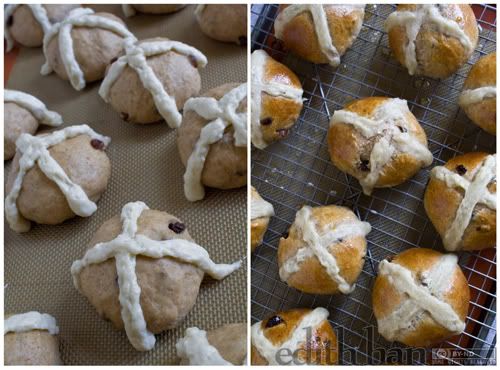
Best on the day they are made. You can heat them up in the toaster or microwave wrapped in a slightly damp paper towel.
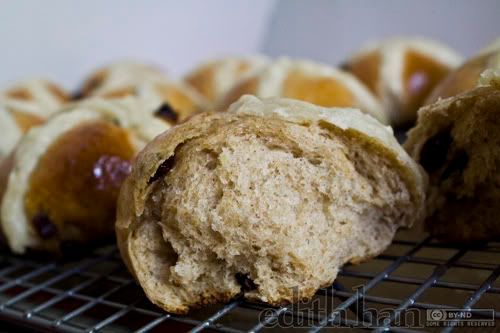



No comments:
Post a Comment
All comments are screened for appropriateness. Commenting is a privilege, not a right. Good comments will be cherished, bad comments will be deleted.